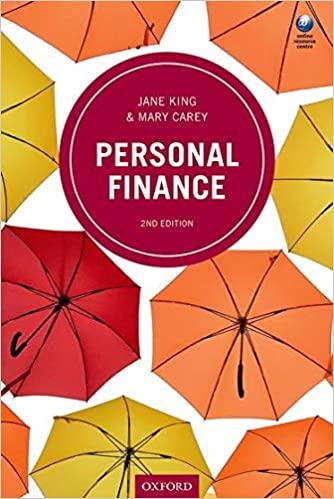Problem CS10 -4: The following data reflect the current financial conditions of Kant Trust Um, Ine... Value of debt (bookmarket) S 1,000,000 Market value of equity $ 6,921,905 Sales, last 12 months S12,000,000 Variable operating costs (50% of sales) $ 6,000,000 Fixed operating costs $ 5,000,000 Tax rate 21% At the current level of debt, the cost of debt, Kais 8 percent and the cost of equity, Kis 10.5 percent. Management questions whether or not the capital structure is optimal, so the financial vice-president has been asked to consider the possibility of rasing an additional $1 million of debt and using the proceeds to repurchase stock. It is estimated that if the leverage were increased by raising the level of debt to $2 million, the interest rate on new debt would rise to 9 percent and Ke would rise to 11.0 percent . The old 8 percent debt is senior to the new debt, and it would remain outstanding, continue to yield 8 percent, and have a market value of S1 million. The firm is a zero-growth firm, with all of its earnings paid out as dividends. 1. Should the firm increase its debt to $2 million? b. If the firm decided to increase its level of debt to $3 million, its cost of the additional S2 million of debt would be 12 percent and K would rise to 15 percent. The original 8 percent of debt would again remain outstanding, and its market value would remain at S1 million. What level of debt should the firm choose: S1 million, $2 million, or $3 million? c. The market price of the firm's stock was originally $20 per share. Calculate the new equilibrium stock prices at debt levels of S2 million and S3 million d. Calculate the firm's earnings per share if it uses debt of $1 million, 82 million, and $3 million. Assume that the firm pays out all of its earnings as dividends. If you find that EPS increases with more debt, does this mean that the firm should choose to increase its debt to S3 million, or possibly higher? e. What would happen to the value of the old bonds if the times more leverage and the old hands are not senior to the new bonds? Problem CS10 -4: The following data reflect the current financial conditions of Kant Trust Um, Ine... Value of debt (bookmarket) S 1,000,000 Market value of equity $ 6,921,905 Sales, last 12 months S12,000,000 Variable operating costs (50% of sales) $ 6,000,000 Fixed operating costs $ 5,000,000 Tax rate 21% At the current level of debt, the cost of debt, Kais 8 percent and the cost of equity, Kis 10.5 percent. Management questions whether or not the capital structure is optimal, so the financial vice-president has been asked to consider the possibility of rasing an additional $1 million of debt and using the proceeds to repurchase stock. It is estimated that if the leverage were increased by raising the level of debt to $2 million, the interest rate on new debt would rise to 9 percent and Ke would rise to 11.0 percent . The old 8 percent debt is senior to the new debt, and it would remain outstanding, continue to yield 8 percent, and have a market value of S1 million. The firm is a zero-growth firm, with all of its earnings paid out as dividends. 1. Should the firm increase its debt to $2 million? b. If the firm decided to increase its level of debt to $3 million, its cost of the additional S2 million of debt would be 12 percent and K would rise to 15 percent. The original 8 percent of debt would again remain outstanding, and its market value would remain at S1 million. What level of debt should the firm choose: S1 million, $2 million, or $3 million? c. The market price of the firm's stock was originally $20 per share. Calculate the new equilibrium stock prices at debt levels of S2 million and S3 million d. Calculate the firm's earnings per share if it uses debt of $1 million, 82 million, and $3 million. Assume that the firm pays out all of its earnings as dividends. If you find that EPS increases with more debt, does this mean that the firm should choose to increase its debt to S3 million, or possibly higher? e. What would happen to the value of the old bonds if the times more leverage and the old hands are not senior to the new bonds







